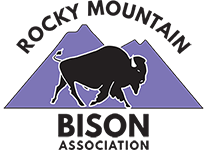By David Easton
High Point Prairie, LLC was formed in the spring of 2013 by myself and Pete Ferrell in the Kansas Flint Hills east of Wichita with the goal of building a quality breeding herd of bison and cattle. The area is part of the last remaining stand of tall grass prairie in the United States. Like every ranch, the area has its challenges and rewards. The Flint Hills are very rocky terrain which has, for the most part made it unsuitable for plowing and tillage. The upside being there is a lot of grass and prairie.
The Ranch
High Point Prairie operates on about 3,000 acres, an hour east of Wichita, on what happens to be one of the highest locations in the area. The elevation varies from about 1300 to 1600 feet on the ranch. There are some nice flat uplands where the wind is always blowing and some steep rock covered hillsides that can’t be ridden on a four wheeler. Sometimes the wind can be a blessing and a nice refreshing breeze. In the winter, not so much.
Water Challenges
One of the main challenges on the ranch is water. The rock formations and geological layers do not lend themselves to water storage very well. Also because the ranch is just slightly higher than the neighbors, water is typically running off the property, not on. In fact I can only think of one location where water is running onto the ranch but at that point it’s in the creek and just continues down the creek. We have several ponds that provide nearly all of the drinking water for the animals. In other places there is water in a draw. Fortunately, we can get pretty good rains to help fill the ponds, but as often happens, we get a big rain after everything is already soaked and watch most of it head down to the neighbors.
Getting Started with Bison
In the spring of 2013, we started off by purchasing about 20 bred heifers, 20 yearling heifers, 100 heifer calves and a few bulls. Later that fall we purchased another 80 yearling heifers followed by several more bulls the next spring. While we got great genetics in our animals, they all came from Colorado, Wyoming or South Dakota and needed time to adjust to the new terrain, climate, forages and management. The herd breed-up was not great for the first couple of years.
In 2016 we made some management changes, mineral program changes and supplement feed changes and finally got over a 90% breed up. Keep in mind that most of the breeding females were born in year 2012 and were raising their first calves in 2015 and that also contributed to a less than stellar breed-up that year. Now, including the cows, two year old heifers, yearling heifers and bulls we have almost 300 animals.
Financial Diversification
We also have about 250 breeding age cattle. Why both bison and cattle? One reason is for financial diversification as a person can purchase many more beef cows than bison cows in today’s market which results in more saleable calves. But that greater number of beef cows will take up more pasture so they won’t generate the same profit per acre as bison. Another reason is they graze a little differently and prefer different plant species to some extent or at different stages. We can also manage the cattle as a tool to impact an area more easily than the bison which tend to be less tolerant of higher stock density and require more fencing to do it.
The bison and cattle have different management requirements as well and I tell many people that some things are easier with cattle and some things are easier with bison. Most cattlemen don’t believe me when I say that, but calving is one example of bison being much easier, it’s best to just get out of the way and leave them alone. Winter time is also easier for the bison to handle as they don’t mind the cold although we get very little snow. We don’t feed either herd hay but we do feed supplemental range cubes. Sorting animals, on the other hand, can be a little more challenging.
Working the Bison Herd
We generally bring the herd into the corral system twice per year. The first time is in the second half of September to sort out the bulls only. We do not put any females or calves in an alley or chute at this time. The second time the herd comes in is typically in January for shots, pregnancy checking and weaning. This is when we will also offer bull calves, or females of varying ages for sale.
Final Thoughts
Over the years I have come to really appreciate the National Bison Association (NBA), Rocky Mountain Buffalo Association (RMBA), and Kansas Buffalo Association, as well as other regional organizations – because of the people in them. There are some outstanding folks raising buffalo who are very willing to share their stories and offer suggestions.
I have also come to realize and I think others would admit, very seldom are things black and white. There are not necessarily clear cut right or wrong ways to manage industry wide but right and wrong ways for the individual producer. This isn’t to say there aren’t “best practices” because I believe there are some. Among them:
- Be an advocate for the animal and the people who care for them
- Always respect and be a student of the animals and your feed resources
- Most definitely, enjoy them as they are fascinating creatures.
